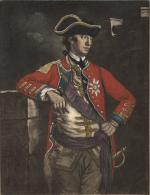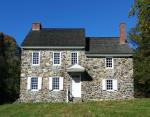![header=[Marker Text] body=[On Sept. 11, 1777, an American force of about 11,000 men, commanded by Washington, attempted to halt a British advance into Pennsylvania. The Americans were defeated near Chadds Ford on Brandywine Creek by approximately 18,000 British and Hessian troops under Howe. ] sign](http://explorepahistory.com/kora/files/1/10/1-A-CB-139-ExplorePAHistory-a0a3y6-a_450.gif)
Mouse over for marker text
Name:
Battle of Brandywine
Region:
Philadelphia and its Countryside/Lehigh Valley
County:
Delaware
Marker Location:
US 1, 1 mile E of Kennett Square
Dedication Date:
March 17, 1952
Behind the Marker
The British decision to advance into Pennsylvania was by no means inevitable, and in retrospect proved a grave mistake for  General William Howe. Entrusting General John Burgoyne to capture the Hudson River Valley and isolate the New England colonies, Howe in the summer of 1777 decided to occupy the rebel capital of Philadelphia. The largest port in the thirteen colonies, Philadelphia was also the hub of a rich agricultural and iron producing region that supplied the Continental army with vital food, munitions, and weapons. Howe strongly believed that by seizing control of Philadelphia he could deliver a devastating blow to the American war effort.
General William Howe. Entrusting General John Burgoyne to capture the Hudson River Valley and isolate the New England colonies, Howe in the summer of 1777 decided to occupy the rebel capital of Philadelphia. The largest port in the thirteen colonies, Philadelphia was also the hub of a rich agricultural and iron producing region that supplied the Continental army with vital food, munitions, and weapons. Howe strongly believed that by seizing control of Philadelphia he could deliver a devastating blow to the American war effort.
On July 23, 1777, Howe and his brother Admiral Richard Howe departed from Sandy Hook, New Jersey, with 18,000 British and Hessian troops on board 260 ships, confident that they could return to New York in time to assist Burgoyne in the Saratoga Campaign. But Howe and his huge armada experienced immediate difficulties. It took them a week to reach Cape May, New Jersey, due to the oppressively humid weather, light winds, and heavy thunderstorms of the Atlantic summer.
Camped in northern New Jersey, Washington quickly learned of Howe’s departure but had no idea of his destination. Nor did members of the Continental Congress, then meeting in Philadelphia. Rumors circulated that Howe intended to recapture Boston. Some believed that the British were headed for South Carolina or Quebec. In a letter to his wife Abigail, John Adams on July 30 wrote, “We know not where [Howe] is gone. We are puzzling ourselves in vain, to conjecture his Intention. Some guess he is gone to Chesapeake, to land near Susquehanna and cross overland to Albany to meet Burgoyne...They may as well imagine them gone round Cape Horn into the South Seas to land at California, and march across the Continent to attack our back settlements.”
That same day, ship pilot Henry Fisher observed the British armada entering the Delaware Bay. When his report reached General Washington in New Hope, Pennsylvania, less than twenty-four hours later, Washington immediately prepared to defend the rebel capital.
Learning that the British were less than a hundred miles away, the Continental Congress requested that New Jersey, Pennsylvania, Delaware, and Maryland assemble their militias to “repel any invasion of the enemy in the said states.” Washington arrived in Philadelphia at 10pm on July 31 and there, for the first time, met the nineteen-year-old French aristocrat Marquis de Lafayette.
Marquis de Lafayette.
Their voyage delayed more than a week by inclement weather, the Howe brothers sailed into a well-defended Delaware River. The Americans had obstructed the river with Frisian horses (chevaux-de-frise)-- long logs tipped with iron spikes-- and two forts, Fort Mifflin and Fort Mercer, protected the approaches to Philadelphia. Rather than risk the destruction of his fleet and ambush by the Continental Army, Howe ordered the British armada to leave the Delaware Bay and undertake a longer voyage down the Atlantic coast to the Chesapeake Bay, from which they would launch their campaign on Philadelphia in northern Maryland. This decision eliminated any hope of returning to assist Burgoyne in New York.
Fort Mifflin and Fort Mercer, protected the approaches to Philadelphia. Rather than risk the destruction of his fleet and ambush by the Continental Army, Howe ordered the British armada to leave the Delaware Bay and undertake a longer voyage down the Atlantic coast to the Chesapeake Bay, from which they would launch their campaign on Philadelphia in northern Maryland. This decision eliminated any hope of returning to assist Burgoyne in New York.
Howe’s decision also dismayed his Hessian officers. “No one any longer knew where we were bound.” Lt. Heinrich von Feilitzsch would write home. “Everyone said something different and everyone had to leave the decision to General Howe.” Fever and dysentery soon inflicted misery on Howe’s 18,000 troops as they suffered through the humid summer heat. The death of large numbers of horses, tossed overboard, then made Howe realize that his advance towards Philadelphia would take even longer to accomplish.
As the Continental Army organized around Philadelphia and the British headed towards the Chesapeake, Washington again lost sight of the mysterious Howe until August 21, a week after the fleet had entered the Bay. To boost local morale, Washington paraded the Continental Army through the streets of the city on its way south to Wilmington, Delaware, Howe’s anticipated destination. The spectacle impressed John Adams, but not Lafayette. “About 11,000 men, ill armed and still worse clothed, presented a strange spectacle,” Lafayette would write. “Their clothes were particolored and many of them were almost naked.”
After a month-long voyage, the British finally landed at the head of the Elk River in northeastern Maryland on August 25. On September 3, William Maxwell’s light infantry division and Johann Ewald’s German Jaegers collided at the small Battle of Cooch’s Bridge near Newark, Delaware. As the American and British generals jockeyed for an advantageous position, the British turned north and headed into Chester County, Pennsylvania.
Although many of his subordinates feared that Howe planned to take Lancaster, York, or Reading, Washington chose to defend the approaches to Philadelphia by placing troops at eight crossing points on the Brandywine River. If Howe did intend to march into Philadelphia through Chester County, the Brandywine obstructed his path. To move an army of 18,000 men, Howe also would need to use the Great Nottingham Road, which crossed the Brandywine at John Chad’s Ford. On September 9, Washington established his headquarters at Benjamin Ring’s house not far from Chad’s Ford. As Howe and his army assembled around modern-day Kennett Square the following morning, Washington confidently waited for British movement and what would become the
John Chad’s Ford. On September 9, Washington established his headquarters at Benjamin Ring’s house not far from Chad’s Ford. As Howe and his army assembled around modern-day Kennett Square the following morning, Washington confidently waited for British movement and what would become the  largest land battle of the Revolution.
largest land battle of the Revolution.
On July 23, 1777, Howe and his brother Admiral Richard Howe departed from Sandy Hook, New Jersey, with 18,000 British and Hessian troops on board 260 ships, confident that they could return to New York in time to assist Burgoyne in the Saratoga Campaign. But Howe and his huge armada experienced immediate difficulties. It took them a week to reach Cape May, New Jersey, due to the oppressively humid weather, light winds, and heavy thunderstorms of the Atlantic summer.
Camped in northern New Jersey, Washington quickly learned of Howe’s departure but had no idea of his destination. Nor did members of the Continental Congress, then meeting in Philadelphia. Rumors circulated that Howe intended to recapture Boston. Some believed that the British were headed for South Carolina or Quebec. In a letter to his wife Abigail, John Adams on July 30 wrote, “We know not where [Howe] is gone. We are puzzling ourselves in vain, to conjecture his Intention. Some guess he is gone to Chesapeake, to land near Susquehanna and cross overland to Albany to meet Burgoyne...They may as well imagine them gone round Cape Horn into the South Seas to land at California, and march across the Continent to attack our back settlements.”
That same day, ship pilot Henry Fisher observed the British armada entering the Delaware Bay. When his report reached General Washington in New Hope, Pennsylvania, less than twenty-four hours later, Washington immediately prepared to defend the rebel capital.
Learning that the British were less than a hundred miles away, the Continental Congress requested that New Jersey, Pennsylvania, Delaware, and Maryland assemble their militias to “repel any invasion of the enemy in the said states.” Washington arrived in Philadelphia at 10pm on July 31 and there, for the first time, met the nineteen-year-old French aristocrat
Their voyage delayed more than a week by inclement weather, the Howe brothers sailed into a well-defended Delaware River. The Americans had obstructed the river with Frisian horses (chevaux-de-frise)-- long logs tipped with iron spikes-- and two forts,
Howe’s decision also dismayed his Hessian officers. “No one any longer knew where we were bound.” Lt. Heinrich von Feilitzsch would write home. “Everyone said something different and everyone had to leave the decision to General Howe.” Fever and dysentery soon inflicted misery on Howe’s 18,000 troops as they suffered through the humid summer heat. The death of large numbers of horses, tossed overboard, then made Howe realize that his advance towards Philadelphia would take even longer to accomplish.
As the Continental Army organized around Philadelphia and the British headed towards the Chesapeake, Washington again lost sight of the mysterious Howe until August 21, a week after the fleet had entered the Bay. To boost local morale, Washington paraded the Continental Army through the streets of the city on its way south to Wilmington, Delaware, Howe’s anticipated destination. The spectacle impressed John Adams, but not Lafayette. “About 11,000 men, ill armed and still worse clothed, presented a strange spectacle,” Lafayette would write. “Their clothes were particolored and many of them were almost naked.”
After a month-long voyage, the British finally landed at the head of the Elk River in northeastern Maryland on August 25. On September 3, William Maxwell’s light infantry division and Johann Ewald’s German Jaegers collided at the small Battle of Cooch’s Bridge near Newark, Delaware. As the American and British generals jockeyed for an advantageous position, the British turned north and headed into Chester County, Pennsylvania.
Although many of his subordinates feared that Howe planned to take Lancaster, York, or Reading, Washington chose to defend the approaches to Philadelphia by placing troops at eight crossing points on the Brandywine River. If Howe did intend to march into Philadelphia through Chester County, the Brandywine obstructed his path. To move an army of 18,000 men, Howe also would need to use the Great Nottingham Road, which crossed the Brandywine at







